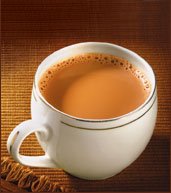The English popularized tea as a hot beverage but it was the Indians who accorded it a mass following. In fact they embraced it with so much fervor and zeal that its consumption in the country surpasses its production. A large quantity of leaf is imported from countries like Sri Lanka, Kenya and so in.
Its relation building and bonding mechanism out does the drink mates in the bar. Many a deals are sealed over a cup of tea hot steaming one at that. In India it is customary to serve chai to official visitors of fellow business men.
In earlier times this beverage was considered as a medicine in the subcontinent. But as the popularity increased the leaf turned into a beverage unsurpassed by any. I remember elders telling me of popularity of milk and jelebies as customary offerings in stalls in India. At that time tea was not in the reckoning at all.
In earlier times this beverage was considered as a medicine in the subcontinent. But as the popularity increased the leaf turned into a beverage unsurpassed by any. I remember elders telling me of popularity of milk and jelebies as customary offerings in stalls in India. At that time tea was not in the reckoning at all.
It was the British who made the brew popular in the country. Themselves fond of this hot beverage they promoted its cultivation in India and developed a vast market as well. Indian Tea Association owned by the British succeeded in conversion of masses into avid tea drinkers during the nineteen hundred.
But the real boost for tea consumption came about during the World War I. The Tea Campaign initiated stalls at factories, coal mines, and mills. This was eventually followed by the tea canteens.
Railways was another booster the Tea Association equipped small contractors with kettles and cups and packets of tea. In the beginning these vendors worked in Punjab, Northwest Provinces and Bengal railway stations.
Railways was another booster the Tea Association equipped small contractors with kettles and cups and packets of tea. In the beginning these vendors worked in Punjab, Northwest Provinces and Bengal railway stations.
The vendors in spite of careful guidance the masters paid no heed and made the hot beverage their own way. This is how chai came into being added with lot of milk and sugar and sometimes jaggery. Till this day the loud call of the vendors Chai!Garam Chai can be heard at each and every railway station.
The next step was to set up stalls in large towns which was resisted by small vendors who brought about a new innovation. They added flavors and spices in order to out bid the larger stalls.
It was at Kanpur that spice tea came into being with the add mixture consisting of cinnamon, cardamom, cloves etc. This tool place in a Kanpur Mill canteen. Much popular all over the World this was later called the masala chai.
It was at Kanpur that spice tea came into being with the add mixture consisting of cinnamon, cardamom, cloves etc. This tool place in a Kanpur Mill canteen. Much popular all over the World this was later called the masala chai.








No comments:
Post a Comment